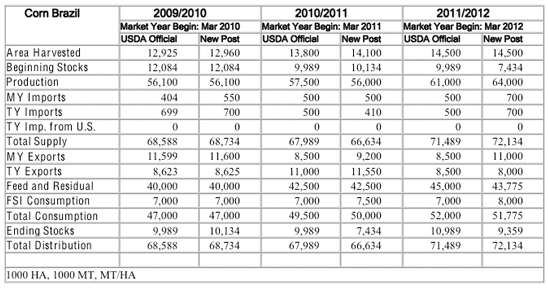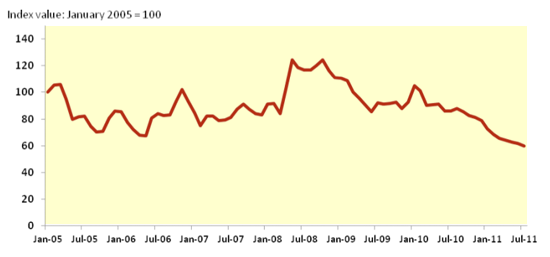



Brazil Grain and Feed Update November 2011
The USDA Foreign Agricultural Service has raised its 2011/12 corn forecast 9 million metric tons (mmt) to 64 mmt in response to attractive export prices, better seed varieties, and an increased second corn crop.CORN

Post raised its 2010/11 estimates for corn planted area from 13 to 14.1 million hectares. Post raised its
2010/11 estimated corn production from 53.5 to 56 million metric tons (mmt). 2010/11 corn production
remained flat in comparison to 2009/2010. The increased planted area should have resulted in increased
crop production, but frosts and droughts led to crop losses in the states of Paraná, Mato Grosso and Mato Grosso do Sul.
Post raised its 2011/12 forecast area planted to corn from 13 to 14.5 million hectares, an almost 3 per cent increase over 2010/11. Post raised its 2011/12 corn production forecast from 55 to 64 mmt, a 14 per cent increase over 2010/11. High corn prices are causing producers throughout the country to dedicate more land to corn production, causing some to shift from other, less profitable commodities such as edible beans and wheat. Post’s 2011/12 corn production forecast is higher than the Ministry of Agriculture, Livestock and Food Supply (MAPA) forecast of 59 mmt but is in line with the forecasts of many of the private analysts.
Producers are able to rely on increased capitalization thanks to the high corn prices over the last year and thanks to forward contracting. High 2010/2011 corn prices, arriving at $19.50/60kg sack were up 30 per cent on the price per sack a year ago. Corn producers are finding increased profit margins with the high corn prices. For the first time, corn producers have had success in forward contracting their 2011/12 corn crop. Post forecasts that producers have forward contracted 30-40 per cent of the total crop already, even before the summer corn crop has been fully planted. It appears that producers are using their increased profits and forward contracts to invest largely in better seed varieties (stacked-trait biotechnology varieties, in particular), fertilizer, agrochemicals, area, and in logistics.
For 2011/12 Post forecasts an increased summer corn crop (safra) planted area and an even greater increase in the winter corn crop (safrinha) planted area. An increased planted area for the summer crop is expected for the states of Tocantins, Mato Grosso, Mato Grosso do Sul, Goias, Minas Gerais, Sao Paulo, Paraná, Santa Catarina and Rio Grande do Sul. Post anticipates increased planted hectares for the winter crop in the Center-West region (Goias, Mato Grosso and Mato Grosso do Sul). Producers in the Center-West have traditionally utilized the limited revenues of the winter corn crop as a side way to offset the transportation costs for their principal soybean crop production. With this mentality, Center- West producers have not historically invested time and resources in the winter corn crop. However, with the profits now available to corn producers, Post anticipates a more intensive and extensive winter crop production in the region. The viability and yield of the winter corn crop is contingent on the soybean cultivation timeframe. With the winter corn crop in mind and thanks to regular rains, soybean producers have been planting the 2011/12 crop on time (September - December), or even earlier. This early soybean planting will provide for an earlier soybean harvest (January - April), and subsequently allow an early winter corn crop planting and harvest. The timing is fundamental for the winter corn crop to avoid the winter frosts and dryness and to adhere to the planting periods as dictated by MAPA’s agricultural zoning program to reduce climactic risk (zoneamento agrícula de risco climático).
Consumption
Post forecasts a 3 per cent growth in 2011/12 corn feed consumption, based on Post’s 3 per cent growth forecast in both the poultry and hog sectors in Brazil. Higher exports and an increase in the domestic consumption of animal proteins, resulting from the higher purchasing power of Brazil’s new middle class, are driving the growth of Brazil’s poultry and hog sectors.
Trade
Post raised its 2010/11 corn export estimate by 1.2 mmt to 9.2 mmt due to high corn prices and increased global demand. Post raises its 2011/12 corn export forecast by 1 mmt to 11 mmt. The 2011/12 corn export forecast is an almost 20 per cent increase over 2010/11. 2011/12 exports should increase to meet increasing global demand and is made possible by the forecast record corn production. As Brazil adopts new seed varieties developed through biotechnology, Brazil will share the biotechnology market restrictions (mostly in shipping to the EU) shared by other large-scale, modernized agricultural producers.
WHEAT

Post maintains 2010/11 wheat production at 5.9 mmt but has lowered its area harvested estimate by 50,000 hectares to 2.1 million hectares. Production in 2010/11 almost reached Brazil’s historic high of 6.1 mmt and benefited from this year’s moderate effect of La Niña. The 2010/11 harvest is almost complete, as the southern wheat-producing states of Paraná and Rio Grande do Sul have harvested 74 per cent and 25 per cent respectively. Mid-harvest observations indicate that the soil and climate in Rio Grande do Sul possess increased productivity potential, which may lead to more extensive wheat production in the state. Domestic wheat quality has been a constant concern for Brazilian millers. Historically, Paraná’s wheat quality has been superior to that of Rio Grande do Sul. This year, however, the rain during harvest has lowered Paraná’s wheat quality. With poor wheat characteristics, millers may be hard pressed to find domestic wheat that meets their requirements and may turn to imports to source their needs.
Post lowered the 2011/12 wheat production forecast by 250,000 mt to 5.15 mmt but maintains the 2011/12 wheat area harvested at 2 million hectares, an almost 8 per cent drop from 2010/11. Post opines
that more intense precipitation prospects will return the 2011/12 wheat production yield forecasts to more conventional levels. Increased corn and soybean planting in Southern Brazil is largely responsible for the decrease in production area.
Trade
While the harvest has proceeded well in accordance with expectations, sales have been slow due to low market prices and competitively-priced, higher-quality imports from Mercosur partners. Many traders believe that profitability for wheat producers has only been possible this year by means of the Brazilian
Government (GOB) support programs (PEP, PROP and AGF). In late September, national producers were heartened by the exchange rate depreciation as the Brazilian Real reached 1.90 against the dollar, making domestic purchases more attractive and imports less attractive to Brazilian millers. Since then, the Real has fallen to 1.68.
Brazilian millers have long sourced Mercosul (particularly Argentine) wheat imports to meet their demands (as domestic production meets only 50 per cent of domestic consumption), but 2010/11 has seen a 14 per cent increase in Argentine flour imports. Brazilian wheat producers and mills allege that Argentine export subsidies are responsible for this increase, placing domestic products and their derivatives at an unfair disadvantage. It is premature to know for certain whether the Brazilian wheat industry will push for international litigation.
Despite the recent Argentine flour incident, Post forecasts that Brazilian mills will import 7 mmt in 2011/12, a close to 5 per cent increase from Post’s last forecast. Consumption growth, from an expanding population and increased use of wheat for feed, will fuel the growth in imports. Poor wheat quality and low market values are the typical determinants for directing wheat for feed.
Post almost doubled its wheat export estimates for 2010/11, from 1.3 mmt to 2.5 mmt. Three factors made such a record export possible. (1) As mentioned above, Brazil’s low domestic wheat quality did not meet domestic milling needs. This created a domestic surplus of low quality wheat that international markets could use for milling or feed. (2) The GOB provided export assistance through its Subsidy Auction Program (PEP—Prêmio para o Escoamento de Produto). (3) The drought over the last couple years in the Russian Federation and its neighboring producers left open wheat market opportunities in Africa (particularly Northern Africa). Brazil was able to take advantage of this opportunity in Africa. While the first and second factor may most likely remain in place for 2011/12, it appears that the Russia Federation is poised to recoup its lost markets and block out potential wheat exports from Brazil. For this reason, Post forecasts 2011/12 exports at 1.1 mmt, a forecast more in line with historic levels.
RICE

Post maintains its 2010/11 estimates for area planted at 2.83 million hectares but raises the 2010/11 milled production by 500,000 mt to 9.3 mmt. The 2010/11 rice crop benefitted from La Niña weather
phenomenon, which favored irrigated rice production. Irrigated rice production accounts for approximately 80 per cent of national rice production. The auspicious weather led to a bumper crop for rice.
Post now forecasts 2011/12 area planted to rice at 2.65 million hectares and production at 8.5 mmt (milled basis). The 2011/12 area planted to rice forecast reflects an almost 7 per cent decrease from 2010/11. In line with MAPA, Post anticipates decreased rice planted area across almost every state, with noted decreased production in Rio Grande do Sul and Paraná. The 2011/12 production forecast shows a 9 per cent decrease from 2010/11, a function of the reduced planted area. In addition, rain shortage concerns in the September-November planting period may negatively impact production yields. Planting in Rio Grande do Sul is far behind: as of October of 2011, the planting is 25 per cent of what it had been at this same period last year. Given Southern Brazil´s rather precise planting window for rice, dictated by climactic conditions, it will be difficult to recover lost time and production later in the harvest cycle.
Depressed rice prices and the prospects of increased profitability from shifting to soybean production are the principal causes of the forecast 2011/12 decrease area planted to rice. Rice prices have dropped due to three factors: high carryover stocks, excellent 2010/11 production, and competitive rice imports from Brazil’s Mercosul partners. Where possible, but especially in Southern Brazil, many producers are shifting from rice into soybean production to take advantage of the better profit margins.
Monthly Average Brazilian Rice Producer Price

Trade
2010/11 trade is particularly characterized by the increased exports thanks in large part to Brazil’s Subsidy Auction Program. Through its PEP auctions, MAPA pays buyers the difference between the market price and the minimum price guaranteed by the government. By means of this mechanism, MAPA provides the minimum price guaranteed to producers and cooperatives and disseminates rice outside the areas of excess supply. PEP ensures this wider dissemination of rice by mandating all buyers to send the purchased rice shipments either to specified northern states of Brazil or to international export markets. In 2010/11 Brazil has already exported 700,000 mt of rice, a 57 per cent increase over the entire 2009/10 year of rice exports. By the end of 2010/11, Post estimates Brazil will have doubled its rice exports with 900,000 mt exported.
Post anticipates that MAPA will continue to strongly implement the PEP program in 2011/12 and forecasts exports at 1.2 mmt. Similar market conditions (namely, low prices, high carryover stocks, and competitive imports from neighboring Mercosur partners) that precipitated PEP’s implementation should continue to characterize the Brazilian rice market in 2011/12.
Further Reading
| - | You can view the full report by clicking here. |








